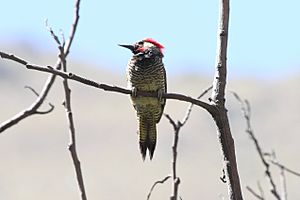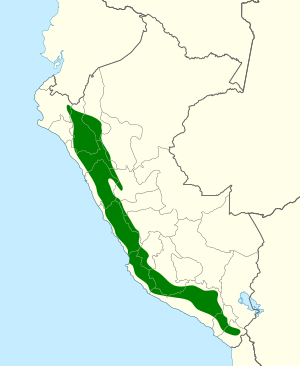Black-necked woodpecker facts for kids
Quick facts for kids Black-necked woodpecker |
|
|---|---|
 |
|
| Conservation status | |
| Scientific classification | |
| Genus: |
Colaptes
|
| Species: |
atricollis
|
 |
|
| Synonyms | |
|
Chrysoptilus atricollis |
|
The black-necked woodpecker (Colaptes atricollis) is a type of bird. It belongs to the woodpecker family. You can only find this bird in Peru. It is sometimes called the black-necked flicker.
Contents
Understanding the Black-necked Woodpecker
What is Taxonomy?
Taxonomy is how scientists classify living things. The black-necked woodpecker was first named Chrysopicos atricollis. Then, it was moved to the group Chrysoptilus. Since about 2007, it has been placed in the Colaptes group.
Different Types of Black-necked Woodpeckers
There are two main types, or subspecies, of the black-necked woodpecker:
- C. a. atricollis (named by Malherbe in 1850)
- C. a. peruvianus (named by Reichenbach in 1854)
What Does a Black-necked Woodpecker Look Like?
This woodpecker is about 26 to 27 centimeters (10 to 11 inches) long. It weighs between 73 and 90 grams (2.6 to 3.2 ounces). Males and females look very similar. Their main differences are on their heads.
Male Woodpeckers
Adult males have a dark gray forehead. Their hindcrown and upper neck are red. Sometimes, the gray feathers have red tips. They have yellowish-white feathers around their eyes. Below their eyes, they have a red stripe called a malar stripe. Their chin and throat are black.
Female Woodpeckers
Adult females only have red on their hindcrown. Their malar stripe is blackish instead of red.
Body and Colors
Both male and female woodpeckers have bronze-green upper parts. These parts have thin black bars. Their lower back and tail feathers are lighter in color. Their flight feathers are dark brown with yellowish bars. Their tail is dark brown. Their chest is black. The rest of their belly is pale yellow with black bars.
Other Features
Their bill (beak) is long and black, with a lighter base. Their eyes are brown or chestnut-brown. Their legs are green-gray.
Young Woodpeckers
Young woodpeckers are usually duller than adults. Their face is darker. The top of their head is often red with dark bars. Their malar stripe is a mix of black and red. The bars on their upper and lower body are less clear.
Subspecies Differences
The C. a. peruvianus subspecies is smaller than the C. a. atricollis type. It also has a shorter bill. Its upper parts are lighter but have more bars. Its underparts are both lighter and have fewer bars.
Where Do Black-necked Woodpeckers Live?
Geographic Location
The C. a. atricollis subspecies lives on the western side of the Andes mountains in Peru. You can find it from the La Libertad area down to the Tacna area. The C. a. peruvianus subspecies lives on the eastern side of Peru's Andes. It is found from the Marañón River valley south into the Huánuco area.
What Kind of Places Do They Like?
These woodpeckers live in many dry or semi-dry places. This includes:
- Dry cloud forests
- Mountain scrublands with cacti
- Desert scrublands
- Forests where trees lose their leaves
- Woodlands near rivers
- Orchards and gardens
Elevation
On the western side of the mountains, they usually live between 500 and 2,800 meters (1,600 and 9,200 feet) high. Sometimes, they can be found as high as 4,000 meters (13,000 feet). In the Marañón Valley, they live between 1,700 and 4,300 meters (5,600 and 14,100 feet) high.
How Do Black-necked Woodpeckers Behave?
Movement and Travel
Black-necked woodpeckers usually stay in the same area all year. However, some might move to different elevations depending on the season.
What Do They Eat?
These woodpeckers eat mostly adult ants. They also eat ant larvae (baby ants) and pupae (ants in a cocoon-like stage). They usually look for food alone or in pairs. They can find food anywhere, from the ground to the tops of trees. They get their food by picking it off surfaces or by probing into cracks.
How Do They Raise Their Young?
The breeding season for black-necked woodpeckers is not fully known. It seems to be mostly around June and July. They make their nests in holes. These holes can be in trees, cacti, utility poles, or even dry river banks. A female usually lays two to four eggs. The eggs hatch after about 14 days. The young birds leave the nest about 28 days after hatching. Both parents help incubate the eggs and feed the baby birds.
What Do They Sound Like?
The black-necked woodpecker makes a "loud clear 'wic'" sound. It often repeats this sound many times. When they are alarmed, they make "peah" and "chypp" calls.
Are Black-necked Woodpeckers Safe?
The IUCN (International Union for Conservation of Nature) says the black-necked woodpecker is a species of "Least Concern." This means they are not currently in danger of disappearing. They live in a large area. Even though we don't know their exact population size, it seems to be stable. There are no immediate threats to them. They are generally uncommon, but you might see more of them in certain places.
See also
 In Spanish: Carpintero peruano para niños
In Spanish: Carpintero peruano para niños


